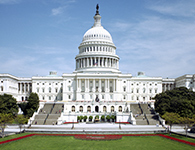EPA Answers NACWA Questions on Proposed NPDES Changes
 NACWA met with EPA staff on June 2 to discuss the Agency’s recently proposed NPDES Updates Rule
NACWA met with EPA staff on June 2 to discuss the Agency’s recently proposed NPDES Updates Rule  . After the Association’s preliminary analysis of the proposal, the meeting provided clarification on the finer points of the proposed changes to the NPDES program. As outlined in the May 23 Current, EPA officials reiterated that the proposed revisions are intended “to eliminate regulatory and application form inconsistencies; improve permit documentation, transparency and oversight; clarify existing regulations; and remove outdated provisions” and they do not believe the proposed changes add additional regulatory burden. The one exception is the proposal to give EPA Regions the discretion to designate an administratively continued permit as a ‘proposed permit’ triggering the required review processes. The extent of the impact on clean water utilities for the bulk of the proposal will depend on how the relevant permitting authorities are currently applying program requirements such as the anti-degradation policy and dilution allowances. For more information, please refer to the recent Current article and upcoming Advocacy Alert.
. After the Association’s preliminary analysis of the proposal, the meeting provided clarification on the finer points of the proposed changes to the NPDES program. As outlined in the May 23 Current, EPA officials reiterated that the proposed revisions are intended “to eliminate regulatory and application form inconsistencies; improve permit documentation, transparency and oversight; clarify existing regulations; and remove outdated provisions” and they do not believe the proposed changes add additional regulatory burden. The one exception is the proposal to give EPA Regions the discretion to designate an administratively continued permit as a ‘proposed permit’ triggering the required review processes. The extent of the impact on clean water utilities for the bulk of the proposal will depend on how the relevant permitting authorities are currently applying program requirements such as the anti-degradation policy and dilution allowances. For more information, please refer to the recent Current article and upcoming Advocacy Alert.
Next week NACWA will issue an Advocacy Alert with a complete analysis of the changes and their implications for clean water utilities, and will submit comments to EPA before the July 18 deadline. Members with any feedback on the rule or concerns can contact Brenna Mannion.
Bipartisan Senate Request for Integrated Planning Funds Sent to Appropriators
 On May 31st, Senators Roy Blunt (R-MO) and Sherrod Brown (D-OH) sent a bipartisan letter
On May 31st, Senators Roy Blunt (R-MO) and Sherrod Brown (D-OH) sent a bipartisan letter  to the Senate Interior & Environment Appropriations Subcommittee requesting that $6.5 million be provided in the Subcommittee’s FY17 Appropriations bill for EPA’s Integrated Planning initiative. This amount of funding would match what was included in the President’s FY17 Budget Proposal and in the House’s FY17 bill that was marked up May 25th, making it more likely to be maintained in subsequent negotiations despite the continued constraints on federal spending. The $6.5 million would support pilot efforts by communities working to implement Integrated Plans and help advance the approach at EPA. In their request, Senators Blunt and Brown noted that an Integrated Planning approach could help communities meet their regulatory obligations under the Clean Water Act (CWA) more flexibly and potentially save ratepayers millions of dollars, while maintaining water quality standards.
to the Senate Interior & Environment Appropriations Subcommittee requesting that $6.5 million be provided in the Subcommittee’s FY17 Appropriations bill for EPA’s Integrated Planning initiative. This amount of funding would match what was included in the President’s FY17 Budget Proposal and in the House’s FY17 bill that was marked up May 25th, making it more likely to be maintained in subsequent negotiations despite the continued constraints on federal spending. The $6.5 million would support pilot efforts by communities working to implement Integrated Plans and help advance the approach at EPA. In their request, Senators Blunt and Brown noted that an Integrated Planning approach could help communities meet their regulatory obligations under the Clean Water Act (CWA) more flexibly and potentially save ratepayers millions of dollars, while maintaining water quality standards.
As previously reported, Senator Brown has also worked to advance Integrated Planning by including its codification along with other valuable CWA reforms in theClean Water Affordability Act. Integrated Planning also emerged in the Senate’s 2016 Water Resources Development Act, which would require EPA to inform municipal dischargers that Integrated Planning is available as a tool and enable EPA to establish compliance schedules beyond the typical NPDES permit cycle. NACWA will continue advocating for both funding and legislation to advance the Integrated Planning approach. Contact Kristina Surfus with questions on Appropriations or Pat Sinicropi to discuss Integrated Planning.
U.S. Supreme Court: Army Corps Jurisdictional Determinations Are Subject to Review
 In a unanimous decision announced May 31, the United States Supreme Court in Hawkes v. US Army Corps of Engineers, held
In a unanimous decision announced May 31, the United States Supreme Court in Hawkes v. US Army Corps of Engineers, held that an approved jurisdictional determination (“JD”) under the Clean Water Act (“CWA”) Section 404 permitting program is subject to immediate judicial review rather than requiring landowners to wait until after the issuance of a permit before bringing a challenge.
that an approved jurisdictional determination (“JD”) under the Clean Water Act (“CWA”) Section 404 permitting program is subject to immediate judicial review rather than requiring landowners to wait until after the issuance of a permit before bringing a challenge.
The 404 permitting process, which applies to the discharge of dredge or fill materials to “waters of the United States,” is often a lengthy and expensive process and landowners cannot legally proceed with projects until the permit is issued. Often the first step in the process is determining whether or not the waters at issue are even subject to the program; i.e., the issuance of a JD by the Army Corps of Engineers. The Court’s decision in favor of judicial review represents a win for NACWA member utilities seeking to complete projects on time and on budget, although it may also open the door to additional citizen suits as environmental groups seek review of determinations that waters are not subject to protection and permitting requirements under the Clean Water Act.
For more facts and background about Hawkes, members can access a recording of NACWA’s March 16, 2016 Hot Topics in Clean Water Law Web Seminar, which featured a presentation from one of the lawyers representing Hawkes Company. NACWA staff also covered the oral arguments in the case in a March 30, 2016 blog post.
DOE and NACWA Discuss Programs to Assist Utilities with Energy Efficiency & Production
 NACWA staff met with Scott Hutchins from the Department of Energy (DOE) Technical Assistance group to discuss the DOE programs that could be beneficial to clean water agencies. DOE has many programs that utilities can take advantage of to increase their use of energy efficient technologies and practices, including the following:
NACWA staff met with Scott Hutchins from the Department of Energy (DOE) Technical Assistance group to discuss the DOE programs that could be beneficial to clean water agencies. DOE has many programs that utilities can take advantage of to increase their use of energy efficient technologies and practices, including the following:
- The Better Buildings, Better Plants Program & Challenge supports a 25% improvement in energy intensity over 10 years. The program has been joined by 18 utilities so far, which makes them eligible for technical support from DOE and national recognition.
- The Combined Heat and Power Deployment Program provides resources to identify CHP opportunities and support installation of CHP systems at wastewater utilities. Site-specific technical assistance is provided through seven regional CHP Technical Assistance Partnerships, which have provided technical support to over 440 CHP projects in recent years.
- Industrial Assessment Centers (IACs) support energy assessments at no cost to municipal water and wastewater utilities. IACs have provided assessments to 58 utilities ranging from 1.6 to 115 MGD.
NACWA and DOE also discussed potential ways to continue raising awareness about both energy efficiency and energy production at wastewater utilities, so that DOE, EPA, and other associations will fully recognize the benefits of energy projects at utilities. NACWA’s Energy Workgroup will be working on this in the coming months, as well as identifying other advocacy work needed to increase energy efficiency and production at utilities. NACWA Member Agencies are encouraged to join the Energy Workgroup by emailing Cynthia Finley.
Department of Justice Files Brief in Support of Groundwater Conduit Theory
 On May 31, the Department of Justice (DOJ) filed an amicus brief
On May 31, the Department of Justice (DOJ) filed an amicus brief 
 in support of the answering brief
in support of the answering brief
 also filed in May by the plaintiffs in Hawaii Wildlife Fund v. County of Maui
also filed in May by the plaintiffs in Hawaii Wildlife Fund v. County of Maui  currently pending before the Ninth Circuit court of appeals. In its brief, DOJ argues that the district court’s decision is consistent both with “the text and purpose of the [Clean Water Act (CWA)]” and with “EPA’s long-held position governing when the CWA requires permits for discharges of pollutants that move to jurisdictional surface waters through groundwater with a direct hydrological connection.” The brief notes that DOJ does not intend that groundwater should be considered waters of the United States and that the district court misapplied the significant nexus test, but that the district court nonetheless reached the right result.
currently pending before the Ninth Circuit court of appeals. In its brief, DOJ argues that the district court’s decision is consistent both with “the text and purpose of the [Clean Water Act (CWA)]” and with “EPA’s long-held position governing when the CWA requires permits for discharges of pollutants that move to jurisdictional surface waters through groundwater with a direct hydrological connection.” The brief notes that DOJ does not intend that groundwater should be considered waters of the United States and that the district court misapplied the significant nexus test, but that the district court nonetheless reached the right result.
The brief argues that the NPDES permit program should only apply to discharges from point sources through groundwater with a “direct hydrological connection” to waters of the United States, and emphasizes that “a general hydrological connection between all groundwater and surface waters is insufficient.” Should the court adopt DOJ’s reasoning in its opinion, however, NACWA member utilities will still be at risk of enforcement and litigation as “direct hydrological connection” is not a clearly defined test and few courts have weighed in on the issue. Because of the risk of citizen suit litigation using the district court’s novel conduit theory for liability under the CWA, NACWA also filed an amicus brief 
 in March urging reversal by the court.
in March urging reversal by the court.
June 15 Webinar to Address Permit Shield Litigation
 On June 15, 2016, at 2:00 PM EDT, NACWA’s Hot Topics in Clean Water Law webinar will address pending litigation that could affect members’ ability to rely on NPDES permit compliance as a shield against citizen suits.
On June 15, 2016, at 2:00 PM EDT, NACWA’s Hot Topics in Clean Water Law webinar will address pending litigation that could affect members’ ability to rely on NPDES permit compliance as a shield against citizen suits.
Clean Water Act (CWA) Section 402(k) establishes that compliance with a NPDES permit is compliance with the CWA and provides a shield from citizen suits (the permit shield). However, environmental groups are using common boilerplate NPDES permit language that incorporates water quality standards by reference to collaterally attack permittees via the citizen suit provision of the CWA.
Richard S. Davis, Beveridge & Diamond, and Karen C. Bennett, Hunton & Williams, will lead a discussion on pending permit shield litigation and efforts to overturn negative lower court precedent. They will inform participants about what to look for in permits and provide recommendations to NPDES permittees on how to object to these unnecessary provisions at the permit issuance stage.
NACWA encourages members to register for this free webinar and engage in the discussion.

Balancing the Need for Investment with Low-income Customer Affordability
As communities across the nation address the ever-pressing need to maintain and update its water infrastructure, a larger question looms, ‘How do sewer and water utilities make these much-needed investments while being mindful about affordability, particularly as it relates to low-income customers?’ NACWA Board Member and Northeast Ohio Regional Sewer District CEO, Julius Ciaccia, talks about how NEORSD is tackling this challenge in this week’s blog.